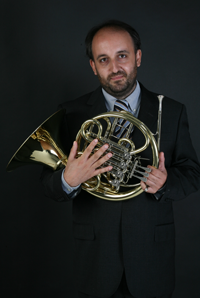
Dur: Ca. 8'
Published in May 2022 at Arpejo Editora
Also available at: June Emerson
The horn repertoire, especially the one written for younger players differs from the repertoire written for advanced and professional students. More than ever it is important that it results in an idiomatic way by taking advantage of the characteristics of the instrument in order to achieve maximum effect with minimal effort. This is an area that has always interested me and that has, moreover, been the subject of my doctoral research. Initially these 5 pieces were composed for euphonium and piano in a challenge, which was launched to me by Arpejo Editora. I was asked to compose a set of 5 pieces for a euphonium and piano with increasing difficulty and that somehow had to be related to the Portuguese popular songbook. From the compositional point of view it was something very attractive given that a good part of the songbook is documented, but at the same time it was a challenge since much of this songbook relies on repetitive rhythmic and melodic elements that gain another dimension with the lyrics. Quite possibly, the songs chosen are unknown to the younger ones, who have lately tended to adopt the songbook from other countries. This is intended to make a small contribution to reversing this trend.
The euphonium shares many of its characteristics with the Wagner Tuba and the horn, so that's why these pieces can also results idiomatically on these instruments. They approach a range where most of the horn players present a embouchure shift. If played on a double horn, it is a good piece to work the thumb movement. It is written in F clef and G clef with ledger lines, becoming a good option to practice different clefs reading. Because it focus on the medium-low and low tange, it is a good choice to practice embouchure shifts or for players on an orthodontic treatment.
“Mirandum se fui a la guerra” [Mirandum went to war] (50'') is a well-known song from Trás-os-Montes and Alto Douro that refers to the Mirandum War 1762, which appears here in a lyrical version. Range: e-d' (PLAYALONG)
“Disse o galo prá galiha” [said the cock to the hen]” (1'14'') is a nursery rhyme from Ribatejo, that in this version has a small cadenza added for the purpose of imitating a chicken by using the half-valve technique. The Cadenza can be adapted or expanded and it should always maintain the comical character. Range: e-e' (PLAYALONG)
“Não se me dá que vindimem” [I don't care if they harvest] (1'12'') it is a song of the wine harvests (Monsanto). It appears here in a simple version played in two different octaves. It is written on the same octave in F clef, so it is a good opportunity to work on modern and old F clef notation. Range: B-c'' (PLAYALONG)
The visit continues in Beira Baixa (Fundão) with “O Milho da Nossa Terra” [the corn of our Earth] (2'15'') which is presented in this version with some rhythmic games and the Lydian dominant mode, that establishes a relationship with the sonority of the harmonic series of the brass instruments. Range: (F in the cadenza) c'-b' (PLAYALONG)
Finally, “Carvalhesa” (2') is a melody from Trás-os-Montes, usually played by a flute and percussion. Thus, the percussion part is performed by beating on the mouthpiece using specific fingerings. It is not necessary to force it, otherwise you might get hurt and the mouthpiece can become stuck on the instrument. You only need to completely seal the mouthpiece with your hand. Range: (C perc.) f-f'' (PLAYALONG)
Ricardo Matosinhos



